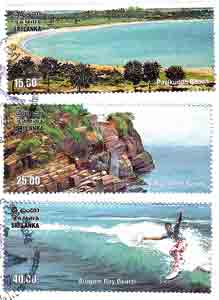The picturesque beaches around the coast of Sri Lanka are some of the valuable natural resources we
possess. The gorgeous beaches in the East coast are amongst the best
tourist attractions.They are also very popular holiday destinations of the local holiday-makers as well.
A series of three stamps released on September 7, 2010 on the theme 'Visit Sri Lanka', featured the "Fantastic Beaches" in the East coast.
Passekudah beach
situated north of Batticaloa is just a few
kilometres from Kalkudah.
In the South West monsoon, the water in Passekudah bay is
crystal clear and still
making it a very safe place even for children. In the past when tourist hotels were virtually unknown, the rest houses
administered by the
government were the only places where visitors could stay. Passekudah rest house situated on the beach itself was one of the most popular spots.
Batticaloa – 'Madakalapuwa' ('mud lagoon' in Sinhala) is not very far away and anyone staying in Passekudah can easily visit the area. A major town in the East, Batticaloa is famed for the singing fish. The story about the fish that sing, is vividly described thus in 'Handbook for the Ceylon Traveller'. "There has been age-old controversy
concerning the source of these sounds (like the
tuning up of a string orchestra, with
predominant basses) but none at all that they exist.
The sounds are best heard from April to September; clearest on moonlight nights, waxing with the moon; and heard to best advantage with an ear placed against an oar thrust into the water from a boat in mid-lagoon. They can even be heard – traffic permitting – from Kalladi bridge to the north of the town. They have been explained variously as caused by fish and
shellfish, of various species or as caused by tides
rushing through empty mollusc shells or fretted rocks in the lagoon bed. Another theory is that they come from the Topsail Catfish which congregates in great numbers in the lagoon during the
appropriate periods."
Batticaloa has a small Dutch fort. In British
times the provincial
administrative centre –
the Kachcheri was
established inside the fort.
Arugam Bay
further to the south is virtually the end of the east coast – at least where tourists are concerned. Today it is a surf resort where
international surfing competitions are held annually. Surfing
enthusiasts find the place an ideal location for the sport, as
depicted in the Rs. 40 stamp.
Arugam Bay, close to Pottuvil, a busy medium size town, is located in close proximity to several attractions. There are at least two ancient Buddhist sites – the Mudu Maha Viharaya virtually on the coast, and the Magul Maha Viharaya, close to Lahugala where herds of elephants can be seen in the luscious grass pastures around the tank. Lahugala is less than 20 km away from Arugam Bay. Kumana national park is only an hour's drive.
The most popular beach close to Trincomalee, the port city of the East
Sri Lanka, is Nilaveli. The stamp features the sea near Swami Rock on which stands a famous Hindu shrine. The spot popularly known as 'Lover's Leap' has a history of a Dutch
official's daughter who had flung herself into the sea because she couldn't bear up her lover sailing away.
Trincomalee (Rs. 25 stamp) has a magnificent natural harbour occupying a strategic position in the Bay of Bengal. The town rests on a narrow
projection of land.
It protects the harbour from the open sea. Sri Lanka's longest and largest river, the Mahaveli enters the sea at Mutur, south of the circular bay.
The colonial
powers were all attracted to Trincomalee. The Portuguese built a fort in 1624. They were ousted by the Dutch in 1639. In 1782, the British drove away the Dutch but the French Fleet re-captured Trincomalee on behalf of the Dutch the same year.
The British forces later took over to seal the first territorial grip on
Sri Lanka. Fort Frederick stands as a historical
monument of the colonial past.
The British had a naval base in Trincomalee, which was taken over by the Bandaranaike government in 1958. |


